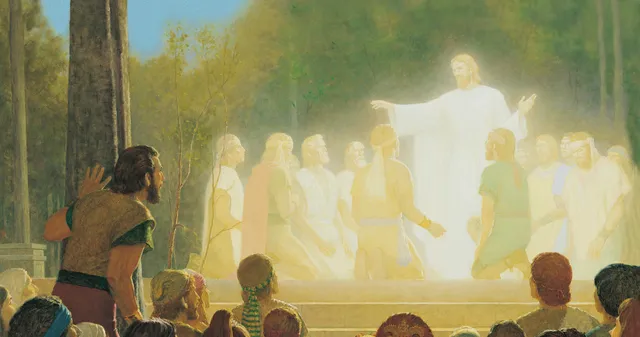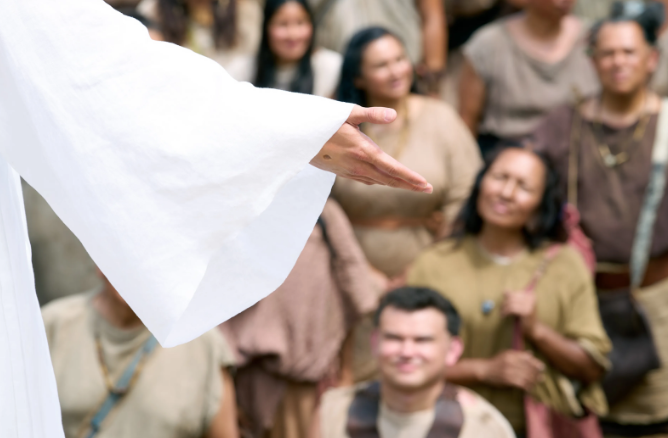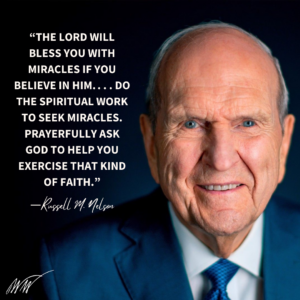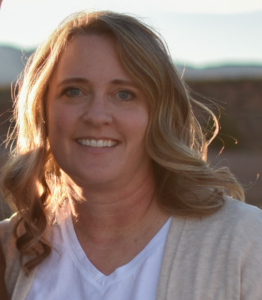
FAIR is a non-profit organization dedicated to providing well-documented answers to criticisms of the doctrine, practice, and history of The Church of Jesus Christ of Latter-day Saints.

“We Rejoice in Christ”
Book of Mormon Chapters: 3 Nephi 17-19
Historical Context: Jesus ministers personally to the Nephites, healing the sick, blessing children, and instituting the sacrament among them.
Some see the temple imagery and practices in 3 Nephi as anachronistic, noting similarities to Old Testament rites. However, these accounts emphasize the temple’s spiritual significance and symbolize Jesus as the great High Priest. His actions—such as blessing children, instructing on prayer, and instituting ordinances—reflect ancient Israelite practices, highlighting the temple’s role in Nephite worship and underscoring key religious principles.
In 3 Nephi 19:4, the names of the Nephite disciples of Christ are listed. One of those names, ‘Timothy,” is a name used by the Greeks and found in the New Testament. Research suggests that the use of the name Timothy in the Book of Mormon is consistent with known historical and cultural interactions between ancient Israel and Greek-influenced regions, emphasizing the diverse heritage of Book of Mormon peoples.
If you have questions on this week’s reading, please email your questions to us here.
There are many principles to find in 3 Nephi 17-19. Some are highlighted in the lesson outline, but you will find others. Let Heavenly Father, through His Spirit, teach you what you need right now.
Henry B. Eyring, “Always Remember Him“
“The Lord’s invitation to let our light so shine is not just about randomly waving a beam of light and making the world generally brighter. It is about focusing our light so others may see the way to Christ. It is gathering Israel on this side of the veil—helping others see the next step forward in making and keeping sacred covenants with God.
The Savior testified, “Behold I am the light; I have set an example for you.” Let’s look at one of His examples.
The woman at the well was a Samaritan who did not know Jesus Christ and was viewed by many as an outcast in her own society. Jesus met her and initiated a conversation. He spoke to her of water. He then led her to increased light as He declared Himself to be the “living water.”
Christ was compassionately aware of her and her needs. He met the woman where she was and started by talking about something familiar and common. If He had stopped there, it would have been a positive encounter. But it would not have resulted in her going to the city to proclaim, “Come, see … : is not this the Christ?” Gradually, through the conversation, she discovered Jesus Christ, and despite her past, she became an instrument of light, shining the way for others to see.”
1-5: Jesus instructs the Nephites to ponder on His words. He will come to them again, but first must go and preach to others of His sheep. The Nephites are in tears, wishing He could stay with them longer.
6-10: The Savior, in His great love for them and because of their great faith, invites any who need healing to come forward. He heals them all.
11-20: The children gather around Jesus. Prior to blessing them, He asks the Nephites to all kneel. He then kneels and prays for them. “No tongue can speak, neither can there be written by any man, neither can the hearts of men conceive so great and marvelous things” as the Nephites heard as the Savior prayed for them. (v.17)
21-25: Jesus then blesses the children, one by one. Angels descend, encircle the children and also minister to them.
1-11: Jesus introduces the sacrament to the Nephites, first to His disciples who then share it with the multitude. The sacrament is an opportunity to covenant to remember Him and keep the commandments. We receive the promise to always have the Spirit to be with us.
12-16: Jesus teaches His apostles to build upon the firm foundation of the commandments and to pray always.
17-25: He then addresses the multitude and admonishes them to also pray always, for their families and for each other. He is the light we need to follow and hold up to the world.
26-34: Jesus then once more addresses only his twelve apostles. He tells them how important it is to only let those who are worthy partake of the sacrament. However, if someone is unworthy, they should be welcomed, ministered to and prayed for.
35-39: Jesus gives the apostles the ability to confer the gift of the Holy Ghost and then ascends into heaven.
1-3: Those who had been present for the Savior’s first visit, labor into the night trying to gather to Bountiful any who were not present.
4-9: A large multitude gathers the next day. They are divided into groups and taught by the twelve apostles. Much time is spent in prayer.
10-14: Nephi is baptized, and then baptizes the other disciples. They receive the gift of the Holy Ghost, “encircled about as if it were by fire.” (v.14)
15-36: Jesus again appears to the Nephites. He requests that they kneel to pray As they all pray fervently, they experience powerful manifestations of the Spirit. The Savior shares that it is their great faith in Him that is enabling the rich outpouring of the Spirit.

…miracles come in all shapes and sizes. We only need to watch for them. In his April 2022 general conference talk President Russell M. Nelson urged members to “seek and expect miracles.”…
In 3 Nephi, we find the account of Christ’s visit to the people in the Americas after His crucifixion. He taught them and ministered to them. But when it was time for Him to leave, Christ could tell that the people wanted Him to “tarry a little longer with them” (3 Nephi 17:5). Although He had other important work to do for the Father, the Savior showed compassion and love by staying with them.
Christ performed many miracles during this extra time He spent with the people. He “cast his eyes round about again on the multitude” (3 Nephi 17:5) and then asked if there were any among them who were sick. The people brought those who were ill forward, and Christ took the time to administer to those who were “lame, or blind, or halt, or maimed, or leprous, or that [were] withered, or that [were] deaf, or that [were] afflicted in any manner” (3 Nephi 17:7). He had compassion for them and healed them.
Miracles happen when we serve with compassion.
compassion.
When Wilford Woodruff was serving his mission in England, he met a woman named Mary Pitt who “had not walked except on crutches for 11 years.”[1] Elder Woodruff baptized Mary on March 31, 1840. A few weeks later, on May 18, 1840, he and others gave Mary a blessing of healing. In a letter to his wife, Phebe, Elder Woodruff described the “notable miracle wrought upon . . . Mary Pitt.” He recounted, “[She] was confined in bed 6 years and has not walked for 11 years only upon crutches. Elders Young, Richards and myself laid hands upon her and she was healed and now walks upright without a crutch or staff.”[2] Elder Woodruff took the time to minister with compassion, just as Christ had done for the people in the Americas.
Christ’s ministry was one of service. Healing the people who were brought to Him led to a spiritual outpouring, and Christ said, “Behold, my joy is full” (3 Nephi 17:20). We can follow the examples of Christ and President Woodruff and minister with love and compassion.
Will we always see miracles like the one received by Mary Pitt? No, but miracles come in all shapes and sizes. We only need to watch for them. In his April 2022 general conference talk, President Russell M. Nelson urged members to “seek and expect miracles.”[3] He said, “The Lord will bless you with miracles if you believe in Him. . . . Do the spiritual work to seek miracles. Prayerfully ask God to help you exercise that kind of faith.”
If we follow the example of the Savior and of President Woodruff and serve with compassion, we can also say that our “joy is full.”
 Michelle graduated from Utah State University–Eastern in 1995 with an associate degree in Graphic Design. After serving in the Guatemala, Guatemala North Mission from 1996 to 1998, she continued her education at Utah Valley University, graduating in 1999 with an associate degree in Paralegal Studies and in 2000 with a bachelor’s degree in Technology Management and an emphasis in Graphic Design. She worked as a paralegal for two years before having her children and becoming a full-time stay-at-home mom. Her two children are now in college. Not wanting to let her children suffer through college alone, Michelle went back to school and is now attending Utah Tech University, working on her master’s in Technical Writing and Digital Rhetoric. Michelle loves the gospel, family history, and the temple. She and her husband enjoy camping, hiking, and spending time together. She is excited to be a volunteer with the Wilford Woodruff Papers.
Michelle graduated from Utah State University–Eastern in 1995 with an associate degree in Graphic Design. After serving in the Guatemala, Guatemala North Mission from 1996 to 1998, she continued her education at Utah Valley University, graduating in 1999 with an associate degree in Paralegal Studies and in 2000 with a bachelor’s degree in Technology Management and an emphasis in Graphic Design. She worked as a paralegal for two years before having her children and becoming a full-time stay-at-home mom. Her two children are now in college. Not wanting to let her children suffer through college alone, Michelle went back to school and is now attending Utah Tech University, working on her master’s in Technical Writing and Digital Rhetoric. Michelle loves the gospel, family history, and the temple. She and her husband enjoy camping, hiking, and spending time together. She is excited to be a volunteer with the Wilford Woodruff Papers.

FAIR is a non-profit organization dedicated to providing well-documented answers to criticisms of the doctrine, practice, and history of The Church of Jesus Christ of Latter-day Saints.
We are a volunteer organization. We invite you to give back.
Donate Now